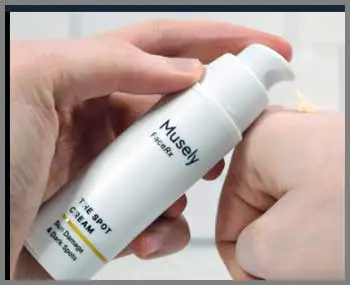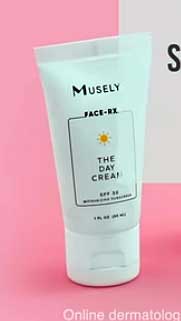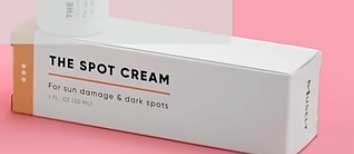If you’ve ever felt the frustration of trying countless over-the-counter serums only to see your stubborn dark spots, sun damage, or melasma stubbornly remain, then you know how disheartening it can be. I was on that same frustrating carousel of products for years.
That is, until I discovered Musely’s prescription-strength approach. This isn’t just another hopeful purchase; it’s a targeted, medical-grade treatment that could finally be the definitive answer to your hyperpigmentation woes. Before you commit, let me share my entire journey, because this powerful cream might just be the solution you need to buy.
My Experience With Musely Dark Spot Remover

My battle with hyperpigmentation began in my late twenties.
It started with a few scattered sun spots from my less-than-diligent sunscreen use in my youth, but after my first pregnancy, it morphed into full-blown melasma.
I developed the dreaded “melasma mustache” on my upper lip and persistent shadowy patches on my cheekbones.
I tried everything: Vitamin C serums, retinol, azelaic acid, niacinamide—you name it, I bought it.
Some things helped slightly, but the underlying patches remained, a constant source of insecurity that had me reaching for heavy concealer every single day. I felt stuck.
That’s when I started seeing ads for Musely. The idea of getting a prescription-strength formula with hydroquinone, the gold standard for treating hyperpigmentation, without a stuffy in-person dermatologist visit was incredibly appealing. The process was surprisingly simple. I went to their website, filled out a detailed questionnaire about my skin history and concerns, and uploaded a few clear photos of my face. Within 24 hours, a board-certified dermatologist reviewed my case and prescribed a custom formula for me—”The Spot Cream” with 12% hydroquinone, kojic acid, and niacinamide.
When the sleek, airless pump bottle arrived, I was both excited and nervous. I had read about the potential side effects, often dubbed the “Musely uglies.” Following the instructions, I started by applying a tiny, pea-sized amount to the affected areas every other night. For the first week, not much happened. Then, the peeling started. It wasn’t drastic, but my skin was definitely shedding. By week two, redness and irritation kicked in. My dark spots actually looked darker and more inflamed. This was the moment I almost gave up, but I trusted the process and the dermatologist’s guidance. I scaled back to every third night and focused on slathering my skin in a thick, gentle moisturizer. After about four weeks, the irritation subsided, and something amazing began to happen. The edges of my melasma patches started to blur. The smaller sun spots were visibly fading. By the eight-week mark, the results were undeniable. My upper lip was almost completely clear, and the patches on my cheeks had lightened by at least 70%. It was the most significant progress I had ever seen from any treatment, and it gave me a level of confidence I hadn’t felt in years.
Read more: My Thoughts on Palmer’s Skin Success Eventone Fade Cream
Pros Of Musely Dark Spot Remover

- Unmatched Prescription-Strength Efficacy: This is the number one reason Musely stands out. Over-the-counter products are limited by law in the concentration of active ingredients they can contain. Musely blows them out of the water by using hydroquinone, a tyrosinase inhibitor that works by decreasing the production of melanin in the skin. While you can find 2% hydroquinone in some store products, Musely’s dermatologists can prescribe formulas containing up to 12%. This high concentration, often combined with other powerful ingredients like tretinoin, kojic acid, or niacinamide, allows the treatment to break down stubborn, deep-set pigmentation that weaker formulas simply cannot touch. My own experience with years of ineffective OTC serums versus just two months of Musely is a testament to this. The results are not just noticeable; they can be genuinely transformative for conditions like melasma and severe sun damage.
- Incredible Convenience of Telehealth: The traditional route for getting a prescription like this involves scheduling a dermatologist appointment (which can take months), taking time off work, traveling to the clinic, and paying a consultation fee. Musely completely streamlines this process. Their online platform allows you to have a virtual consultation from the comfort of your own home. You simply provide your medical history and photos of your skin, and a real dermatologist reviews your case and customizes a treatment plan. The initial online doctor visit is affordable, and the entire process, from consultation to having the prescription delivered to your door, can take as little as a few days. This accessibility removes a massive barrier for people who need medical-grade skincare but lack the time or resources for traditional appointments.
- Customized Formulations for Your Specific Needs: Musely isn’t a one-size-fits-all product. Based on your consultation, the dermatologist will choose the best formula for your skin type and the severity of your hyperpigmentation. For example, someone with sensitive skin might start with a lower concentration of hydroquinone, while someone with resilient skin and deep melasma might get a more potent blend. The creams are often combination formulas, which is a huge advantage. My cream had hydroquinone to block melanin, kojic acid to further inhibit pigment, and niacinamide to reduce inflammation and support the skin barrier. This multi-pronged approach attacks hyperpigmentation from different angles, often leading to better and faster results than using a single-ingredient product.
- Visible and Relatively Fast Results: While patience is still a virtue in skincare, the timeline for seeing results with Musely is significantly shorter than with most non-prescription alternatives. Because of the potency of the ingredients, many users, myself included, begin to see a noticeable fading of dark spots within 6 to 8 weeks of consistent use. For people who have been struggling for years with discoloration, seeing this kind of visible progress in just a couple of months can be a massive confidence booster and provides the motivation needed to stick with the treatment plan through the initial adjustment period. It provides hope and tangible results where other products may have failed.
Cons Of Musely Dark Spot Remover
The Infamous Adjustment Period
- The “Musely Uglies” Are Real: You can’t talk about the pros of Musely without being brutally honest about the initial side effects. The powerful ingredients, particularly hydroquinone and tretinoin (if included in your formula), work by accelerating skin cell turnover and blocking pigment production. This process can be very irritating at first. Common side effects include redness, dryness, significant peeling, and a feeling of tightness or stinging. For me, my dark spots temporarily appeared darker and more inflamed against the red, peeling skin, which was alarming. This phase, often called the “Musely uglies,” typically lasts from 2 to 6 weeks. It requires patience and a commitment to babying your skin to get through it. If you’re not prepared for this adjustment period, it can be very tempting to quit before you see the amazing results on the other side.
Cost and Subscription Model
- It’s an Ongoing Investment: Musely is not a one-time purchase. It operates on a subscription model where you are automatically charged and shipped a new bottle every two months. While the cost is generally less than a traditional dermatologist visit plus a separate prescription fee, it is still a significant recurring expense compared to a drugstore serum. You need to factor this ongoing cost into your budget. Furthermore, because the treatment is so potent, you will need to invest in other high-quality skincare products—specifically a very gentle cleanser, a rich barrier-repairing moisturizer, and a high-SPF, broad-spectrum sunscreen—to support your skin, which adds to the overall cost.
The Hydroquinone Controversy
- Potential for Side Effects and Necessary Breaks: Hydroquinone is a powerful and effective ingredient, but it is not without controversy. It should not be used long-term without breaks. Continuous use over many months or years can, in rare cases, lead to a condition called ochronosis, which is a paradoxical darkening and blue-black discoloration of the skin that is very difficult to treat. This is why dermatologists prescribe a “cycling” schedule, where you use the hydroquinone cream for a treatment period (e.g., 3-4 months) and then switch to a non-hydroquinone maintenance cream for a “rest period.” You must be diligent about following your doctor’s instructions for cycling off the medication to use it safely and effectively.
Maintenance Tips For Musely Dark Spot Remover
Start Slow and Be Patient
- Short Contact Therapy is Your Best Friend: When you first receive your Spot Cream, resist the urge to slather it on every night, hoping for faster results. This is a marathon, not a sprint. The best way to introduce this potent cream to your skin and minimize the dreaded “uglies” is through short contact therapy. For the first week, try applying a very thin layer to the affected areas and leaving it on for just 30 minutes before gently rinsing it off and applying your moisturizer. The next week, you can increase it to an hour, and so on. This method allows your skin to gradually acclimate to the active ingredients, significantly reducing the initial shock of redness and peeling.
- Alternate Nights in the Beginning: Once your skin has handled short contact therapy, you can move to leaving it on overnight. However, do not start with nightly use. Apply the cream only once every third night for the first couple of weeks. If your skin is tolerating it well, you can then increase to every other night. It may take a month or more before you can comfortably use it every single night, and that’s perfectly okay. Listening to your skin is the most important rule. Pushing it too hard, too fast will only lead to a compromised skin barrier and more inflammation, which can actually worsen hyperpigmentation.
Build a Supportive Skincare Fortress

- Simplify Your Routine: This is not the time to be experimenting with other active ingredients. While using Musely, your skincare routine should be stripped back to the gentle basics. Your goal is to support and protect your skin barrier. This means pausing any other exfoliants like AHAs, BHAs, physical scrubs, and even potentially irritating Vitamin C serums, unless cleared by your Musely dermatologist. Your routine should consist of three simple steps: a gentle, hydrating cleanser that doesn’t strip your skin; the Musely cream (at night); and a thick, soothing moisturizer.
- Moisturize Like Your Skin Depends On It: A high-quality barrier repair cream is non-negotiable. The ingredients in Musely can be very drying, and a compromised moisture barrier will amplify irritation. Look for moisturizers packed with ingredients like ceramides, hyaluronic acid, glycerin, and shea butter. Apply a generous layer of moisturizer 10-15 minutes after your Musely cream has fully absorbed. Some users even find success with the “sandwich method,” where you apply a thin layer of moisturizer, wait for it to absorb, apply your Musely cream, and then apply another layer of moisturizer on top. This creates a buffer that can help reduce irritation without diluting the efficacy of the treatment.
Sunscreen is Not a Suggestion, It’s a Commandment
- Become a Sunscreen Fanatic: Using a potent melanin-inhibitor like hydroquinone makes your skin significantly more sensitive to the sun. Sun exposure while on this treatment will not only negate your results but can actively make your hyperpigmentation worse. You must commit to using a broad-spectrum sunscreen with an SPF of 50 or higher every single day, without exception. This means even on cloudy days, even when you’re just sitting by a window, and even for short trips outside. Reapply your sunscreen every two hours if you are outdoors. A mineral-based sunscreen with zinc oxide or titanium dioxide can be a good choice as it tends to be less irritating for sensitized skin. Consider this part of the treatment itself.
Comparison With Other Brands
When tackling hyperpigmentation, Musely’s prescription-strength approach is a heavy hitter, but it’s important to understand how it compares to other options on the market.
Over-The-Counter (OTC) Serums
- Active Ingredients: This is the biggest differentiator. OTC serums from brands like The Ordinary, La Roche-Posay, or SkinCeuticals rely on ingredients like Vitamin C, niacinamide, azelaic acid, kojic acid, and retinol. While these are all fantastic ingredients for general brightness and mild discoloration, they are significantly less potent than prescription-strength hydroquinone or tretinoin. They work more slowly and are generally better suited for preventing new spots or treating very light, surface-level hyperpigmentation.
- Mechanism and Results: OTC products primarily work by exfoliating the top layer of skin and offering antioxidant protection. Musely’s hydroquinone-based formulas work on a cellular level to actively shut down the overproduction of melanin. This is why Musely can produce dramatic results on deep, stubborn melasma and sun damage where OTC products often fail to make a significant dent. The trade-off is that OTC products have a much lower risk of irritation.
- Accessibility and Cost: OTC serums are readily available at beauty stores and pharmacies without a prescription. They are often more affordable upfront, though the cost can add up over time as you try different products hoping for results. Musely requires a medical consultation but provides a direct-to-consumer pathway for a much stronger, targeted treatment.
In-Office Procedures and Other Prescriptions
- Chemical Peels and Lasers: Procedures performed in a dermatologist’s office, such as deep chemical peels or laser treatments (like Fraxel or IPL), can offer very rapid and dramatic results. However, they come with a hefty price tag, often costing hundreds or even thousands of dollars per session, and multiple sessions are usually required. They also involve significant downtime with intense peeling and redness. Musely offers a more gradual, at-home alternative that is far more affordable and involves less disruptive downtime.
- Standalone Prescription Tretinoin: Tretinoin (prescription Retin-A) is another gold-standard ingredient for hyperpigmentation and anti-aging. A dermatologist can prescribe it on its own. It works by accelerating cell turnover to shed pigmented cells. While highly effective, it can also be very irritating. Musely’s advantage is its combination therapy; the formulas often include tretinoin alongside hydroquinone and soothing ingredients like niacinamide, creating a multi-faceted approach in a single, convenient product that can be more effective and sometimes better tolerated than tretinoin alone.
Also read: My Thoughts on Redness Defense Green Primer
Frequently Asked Questions (FAQ)
The “highest rated” dark spot remover often depends on the type and severity of the dark spots. For stubborn, deep-set hyperpigmentation like melasma, prescription-strength treatments containing hydroquinone, such as Musely or those prescribed directly by a dermatologist, are consistently rated as the most effective. For milder, surface-level spots, highly-rated over-the-counter options often include serums with Vitamin C, retinol, or azelaic acid.
Yes, for the vast majority of users with hyperpigmentation, Musely is extremely effective. Its formulations use prescription-strength ingredients that are clinically proven to inhibit melanin production and increase cell turnover. While individual results can vary, countless user testimonials and before-and-after photos show significant, often dramatic, fading of melasma, sun spots, and post-inflammatory hyperpigmentation.
When you stop using the hydroquinone-based Spot Cream, the melanin-blocking effect ceases. Since hyperpigmentation can be a chronic condition, there is a possibility that the dark spots can return, especially if triggered by sun exposure or hormonal changes. This is why Musely has a long-term maintenance plan that involves “cycling” off hydroquinone and using a non-hydroquinone “maintenance” cream to preserve your results and prevent recurrence. Diligent, lifelong sunscreen use is the most critical factor in keeping spots from returning.
The most common side effects occur during the initial adjustment period and can include redness, dryness, peeling, flaking, and a stinging or itching sensation. Some users may also experience an initial purging of acne. These side effects are temporary for most people and can be managed by starting slowly and using a supportive skincare routine. In rare instances, hydroquinone can cause more serious side effects like ochronosis (paradoxical skin darkening) if used improperly for extended periods without breaks.
Conclusion
So, is the Musely Dark Spot Remover worth it? For me, the answer is an unequivocal yes. It was the only treatment that made a real, visible difference on melasma and sun damage that I had been battling for years. While the initial irritation period is challenging and the cost is a recurring commitment, the results speak for themselves. If you have tried everything else on the shelf and are still fighting a losing battle against stubborn hyperpigmentation, I strongly encourage you to consider this prescription-strength solution. It’s a serious treatment, but it delivers serious results.
